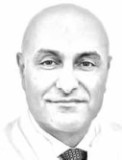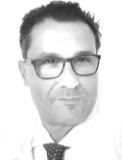A moving target: the future of cardiology
- In Healthmanagement
- Tue, 21 Aug 2018
In this issue of HealthManagement, we shine the spotlight on two leading figures in the field of cardiology—Prof. Dr. Hüseyin Ince and Dr. Giuseppe D'Ancona—to bring together their expert views on key developments in transcatheter aortic valve implantation (TAVI), percutaneous mitral valve repair and more.
Giuseppe D’Ancona (GD): Improved valve sealing of the calcified aortic annulus to reduce risk of paravalvular leak and complete valve “resheathability” to guarantee stable valve re-positioning within the optimal landing zone are the most important achievements of the new generation TAVI devices.
Hüseyin Ince (HI): We believe that the next frontier will be treatment of pure aortic insufficiency by means of TAVI. Although this procedure has been so far performed mainly as an off-label approach to treating selected patients, technology in the future should make devices available that are optimised for this goal.
HI: Large scale clinical trials involving both the Medtronic and Edwards systems have been approved and are ongoing in the low-surgical-risk category. Moreover, the Nordic Aortic Valve Intervention (NOTION) trial (Thyregod et al. 2013), where 81% of the patients had low-surgical-risk, has shown that the primary endpoint of death due to any cause, stroke and myocardial infarction at one year were similar in TAVI and conventional aortic valve replacement patients. The TAVI group had lower rates of bleeding, acute kidney injury, new or worsening atrial fibrillation or cardiogenic shock, as well as a shorter length of stay and larger orifice areas. Surgical patients had lower rates of pacemaker implantations and paravalvular regurgitation, and had a better New York Heart Association Classification at one year.
GD: We have to be realistic about the future expansion of TAVI and we need to understand that we are dealing with a moving target. Although some questions about valve durability, leaflet thrombosis, and higher rates of paravalvular leak and post-procedural permanent pacemakers (PPMs) implantation have been raised in the TAVI arena, most of these issues will be overcome as TAVI technology continues to improve. In this context, TAVI in low-risk candidates will be just a natural consequence.
GD: Apart from our experience, there is published evidence that a large majority of patients implanted with PPM immediately after TAVI do not require a PPM at short-term follow-up. In synthesis, we implant more PPMs than necessary after TAVI.
There are some general and specific rules you can apply to reduce the PPM implantation rate after TAVI. Generally speaking, you should implant with PPM only those patients that, after TAVI, present indications to PPM according to international guidelines—that would not include patients with new onset of left bundle branch block (LBBB), for example. Moreover, because the lesion on the cardiac conduction tissue (specifically the AV node) may be temporary, we delay to the fifth day after TAVI the decision to implant a PPM. Of course, in the meantime patients are monitored and a temporary pacemaker lead is left in place (via the jugular vein).
Finally, because the conduction blocks are generally caused by localised oedema and direct trauma—exerted by the catheter during the procedure and by the valve stent―we start steroidal therapy to facilitate oedema reduction. This strategy has already been suggested in the paediatric population after percutaneous closure of septal defects.
HI: From a more explicitly technical standpoint, we have learned that aiming for a “high implantation” of the prosthesis within the native aortic annulus will reduce the risk of impingement in the conduction system and minimise the development of AV block. Again, this is not just a personal intuition but has been confirmed by other authors who have used prostheses with a different design.
The implantation depth can be corrected when using completely resheathable and repositionable TAVI prostheses. With the LOTUS® valve, we had a learning curve of more than 30 patients before we could optimise our implantation technique and, in the last series, drastically reduce the PPM implantation rate.
HI: We have to operate within the indications of the international guidelines. Because we are mainly addressing patients within the EU, we refer to the EU guidelines. In this context, in primary mitral valve regurgitation, percutaneous edge-to-edge procedure is indicated in patients with symptomatic severe primary mitral regurgitation who fulfil the echocardiographic criteria of eligibility and are judged inoperable or at high surgical risk by the heart team, avoiding futility.
In secondary mitral valve regurgitation, when revascularisation is not indicated and surgical risk is not low, a percutaneous edge-to-edge procedure may be considered in patients with severe secondary mitral regurgitation and left ventricular ejection fraction (LVEF) >30% who remain symptomatic despite optimal medical management—including cardiac resynchronisation therapy (CRT) if indicated—and who have a suitable valve morphology by echocardiography, avoiding futility.
GD: In patients with severe secondary mitral regurgitation and LVEF <30% who remain symptomatic despite optimal medical management—including CRT if indicated—and who have no option for revascularisation, the heart team may consider a percutaneous edge-to-edge procedure or valve surgery after careful evaluation for a ventricular assist device or heart transplant according to individual patient characteristics.
GD: For years there has been a fallacious tendency to underestimate the peri-procedural and follow-up risks of CIEDs. In this context, there has been a liberal interpretation of the international guidelines, which are also indirectly driven by the fact that in many medical institutions, CIED implantation represents a source of budgetary income. Moreover, with the improvement of techniques and technology, patients with more complex co-morbid profiles, often leading to a higher vulnerability towards infections, have also been targeted for CIED implantation.
CIEDs often represent a necessary tool quoad vitam et valitudinem (with respect to life and to health), and an increase in CIED infection rates also results from a broader application of this type of therapy to borderline co-morbid patients. In light of the not negligible risks, it should be common strategy to adhere even more to the international guidelines for CIED implantation.
HI: That said, we should keep in mind that guidelines are, in any case, prone to changes based on the most recent scientific evidence. It should be enough to think, for example, about the recently published DANISH trial (Køber et al. 2016) findings that have emphasised the lack of survival benefits in selected groups of implantable cardioverter defibrillator (ICD) candidates. In this sense, we have to be aware of the fact that in the past years, a more defensive approach has been applied in the field of CIEDs.
HI: Cybersecurity in CIEDs is a big challenge, mainly due to the fact that, as healthcare providers, we have limited knowledge and tools to understand and prevent risks of malicious hacking into CIEDs. The Heart Rhythm Society’s Leadership Summit has only recently published a document (Slotwiner et al. 2018) to create awareness and propose solutions.
Cybersecurity vulnerability is not insurmountable, as long as we realise its existence. In fact fear of hacking should not generate panic and immobility but, on the contrary, enhance prompt multidisciplinary solutions.
For the future one of the primary goals should be to educate healthcare providers and patients about the risks of cybersecurity breaching and the actions already taken by stakeholders to minimise those risks.
GD: From a more technical standpoint, the stakeholders should be incorporating cybersecurity features into the early stage of product design. In this context, they will also need to propose and develop infrastructure to evaluate and limit specific CIED vulnerabilities that may arise after implantation and during the follow-up phases.
We have to emphasise that hacking of CIEDs is only one of the many aspects of potential security breaching in the modern healthcare era. In fact, the digitalisation of medicine and medical information is forcing us to secure the huge amount of medical data that is generated. Again, as healthcare providers, we must put pressure on the policymakers and the technical people to come up with reasonable and prompt solutions that will minimise the risks for healthcare seekers, without impairing their daily medical management.
GD, HI: Percutaneous treatment of structural heart disease is a main field of academic and clinical activity of our multidisciplinary department, with a holistic approach to cardiovascular medicine.
Are there any areas in particular where you believe more research is required?
GD, HI: Although we are mainly acting on the consequences of cardiovascular disease, we believe that more efforts should be invested in the cardiovascular prevention and education field. In this context, our job is mainly technical and we must recognise the limited span of action we may have with our expertise. The impact on the overall population would be much greater if more efforts were concentrated on the earlier stages of disease or before the disease has developed.
HI: It is a real challenge to predict the next major breakthrough in cardiology. In any case, the most important discoveries will result from team and collaborative science and multidisciplinary studies. We see a huge potential in translational research, particularly within active and continuous integration and liaison among those involved in big data interpretation, bench experimentation and bedside application. This integration may lead to significant future breakthroughs in the field of cardiovascular medicine.
GD: In our specific field of percutaneous treatment of structural heart disease, we are expecting major breakthroughs in the percutaneous management of mitral valve pathology, particularly mitral valve regurgitation, heart failure, and in the percutaneous management of treacherous acute conditions such as ascending aorta dissection.
In our ageing population, do you think incidences of cardiovascular disease will be on the rise, or do you think changes to the healthcare system can prevent these incidences?
GD: Although we know that most cardiovascular diseases can be prevented by addressing behavioural risk factors using population-wide strategies, cardiovascular pathology is a technical consequence of organism ageing. It has to be emphasised that, in any case, the lethal consequences of cardiovascular disease can be nowadays delayed and buffered by early diagnoses and treatment. As a result, although an increase in cardiovascular disease related to ageing of the population may be expected, its impact upon patients´ mortality should be contained.
HI: But we have unfortunately a very limited perspective that mainly considers what we call “the developed world”. It will be of crucial importance to investigate and monitor what will happen in emerging economies. Certain aspects of cardiovascular disease, in fact, belong mainly to rich economies and may emerge aggressively in developing countries, especially as a result of changing habits in emerging economies.
Køber L et al. (2016) Defibrillator implantation in patients with nonischemic systolic heart failure (DANISH trial). N Engl J Med 375: 1221-230.
Ortak J et al. (2018) Transcatheter aortic valve implantation with a mechanically expandable prosthesis: a learning experience for permanent pacemaker implantation rate reduction. Eur J Med Res 23 (1): 14.
Slotwiner DJ et al. (2018) Cybersecurity vulnerabilities of cardiac implantable electronic devices:communication strategies for clinicians—Proceedings of the Heart Rhythm Society's Leadership Summit. HeartRhythm 15(7): e61–7.
Thyregod HG et al. (2013) The Nordic aortic valve intervention (NOTION) trial comparing transcatheter versus surgical valve implantation: study protocol for a randomised controlled trial. Trials 14:11.
Voigt A et al. (2010) Continued rise in rates of cardiovascular implantable electronic device infections in the United States: temporal trends and causative insights. Pacing Clin Electrophysiol 33:414–19.
TAVI, CIED, transcatheter aortic valve implantation, percutaneous mitral valve repair, implantable electronic devices
In this issue of HealthManagement, we shine the spotlight on two leading figures in the field of cardiology




